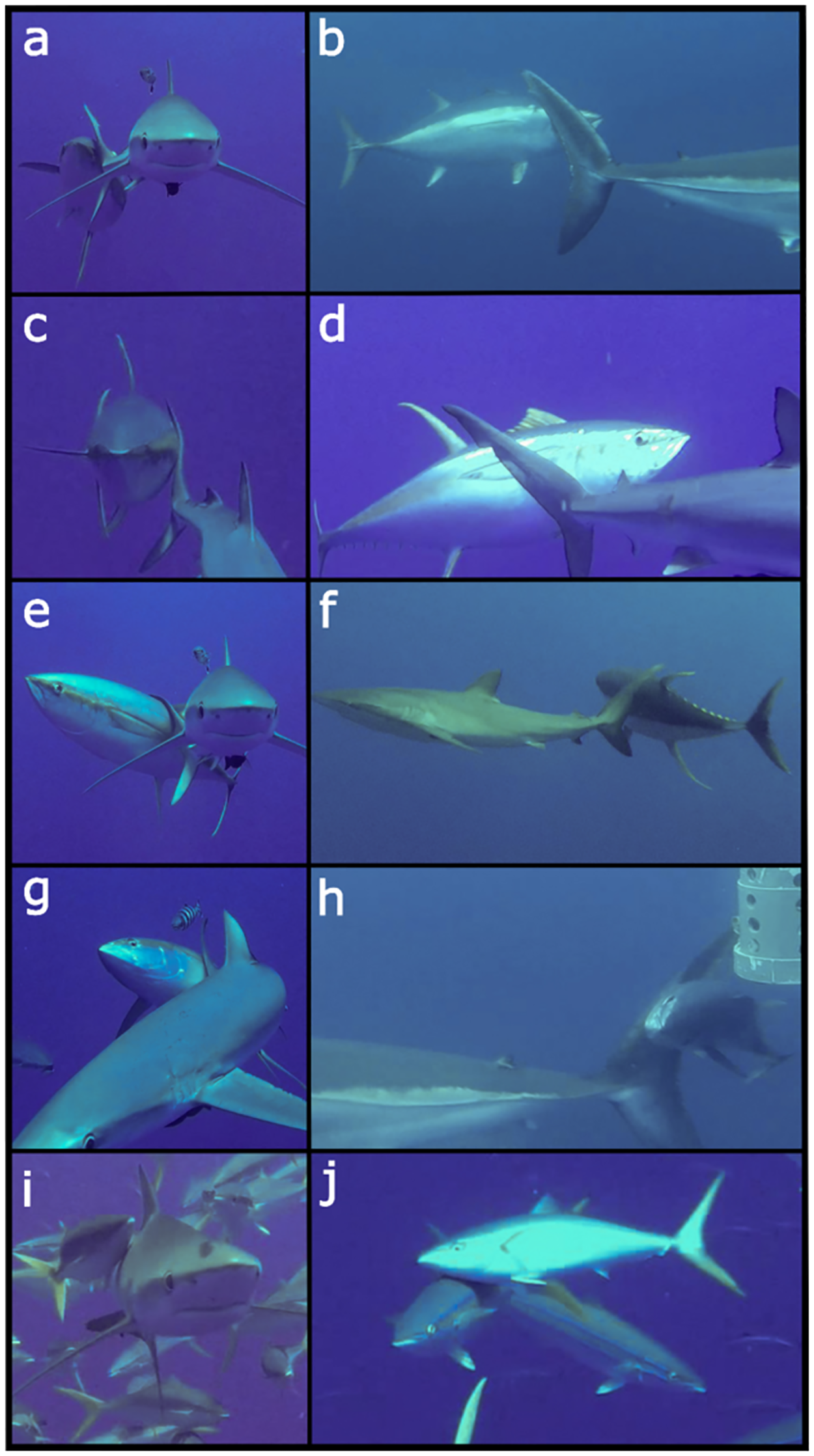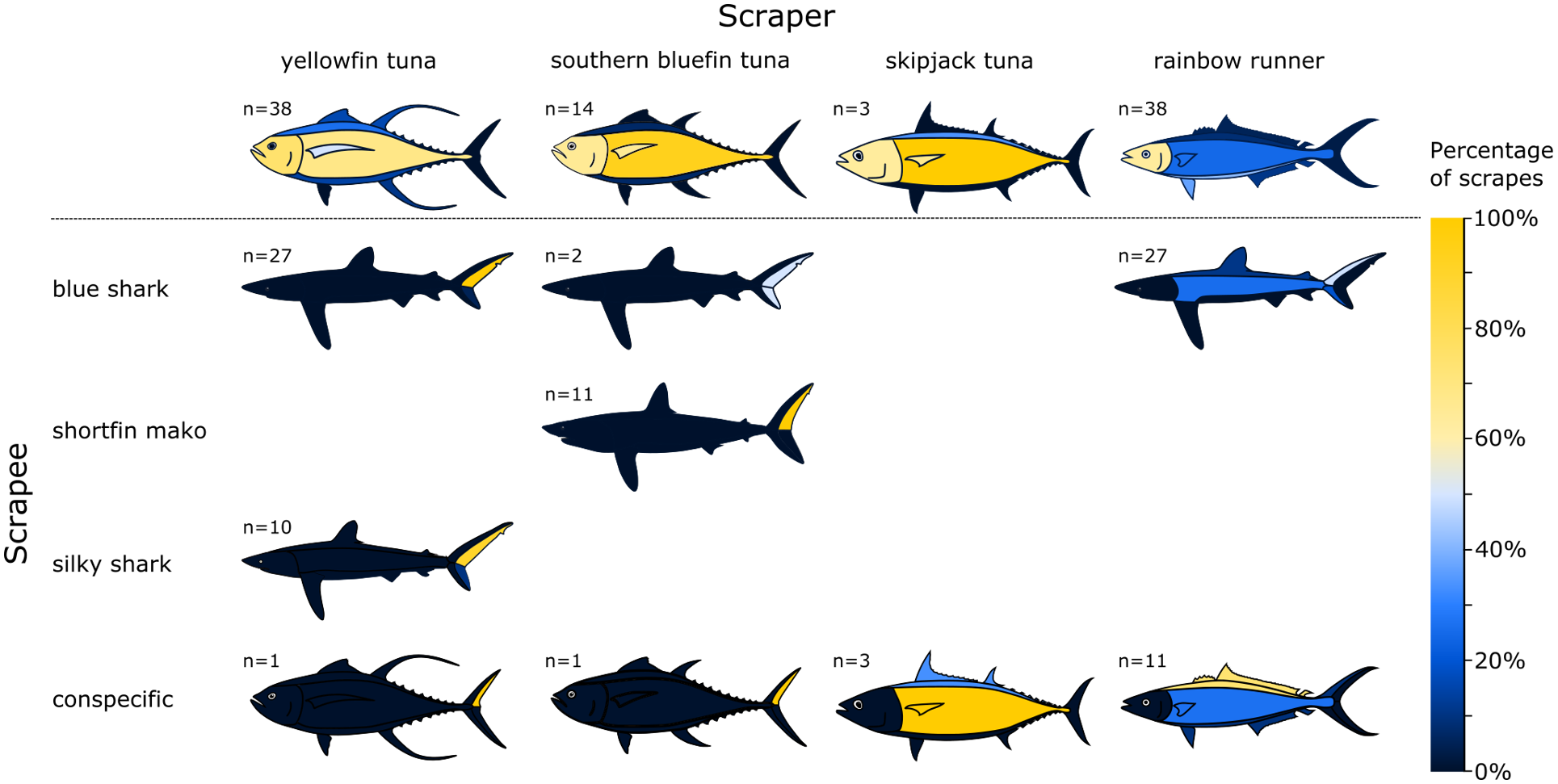Sharks are the preferred scraping surface for large pelagic fishes: Possible implications for parasite removal and fitness in a changing ocean
Chris Thompson | Oct 2022
New publication
Highlights
Parasites can negatively affect the fitness of their hosts by draining resources and diverting energy from growth, reproduction and other bodily functions.
Pelagic fishes are hosts to a diverse array of parasites, however, their environment provides few options for removal.
We found that scrapers preferred scraping their head, eyes, gill cover and lateral surfaces – areas where parasites are commonly found and where damage would likely have a substantial impact on fitness.
Lengths of scrapers and scrapees were positively correlated and fish scraping on sharks were larger than those scraping on members of the same species, suggesting that risk of predation may be a limiting factor.
The decline of shark populations in the world’s oceans and the reduction in the mean size of many species may limit these interactions, eroding possible fitness benefits associated with this behaviour and consequently placing more pressure on already highly targeted and vulnerable species.
Abstract
Mutualistic and commensal interactions can have significant positive impacts on animal fitness and survival. However, behavioural interactions between pelagic animals living in offshore oceanic environments are little studied. Parasites can negatively effect the fitness of their hosts by draining resources and diverting energy from growth, reproduction, and other bodily functions. Pelagic fishes are hosts to a diverse array of parasites, however their environment provides few options for removal. Here we provide records of scraping behaviour of several pelagic teleost species, a behaviour that is likely used for parasite removal. These records span three ocean basins and, to the best of our knowledge, include the first records of scraping interactions involving tunas, blue sharks, and mako sharks as well as the first records of intraspecific scraping. We found that scrapers preferred scraping their head, eyes, gill cover, and lateral surfaces, areas where parasites are commonly found and where damage would likely have a substantial impact on fitness. Scraper species varied in their scraping preferences with tunas scraping mostly on the posterior caudal margins of sharks and occasionally conspecifics, while rainbow runner scraped in more varied locations on both sharks and conspecifics. Lengths of scrapers and scrapees were positively correlated and fish scraping on sharks were larger than those scraping on conspecifics, suggesting that risk of predation may be a limiting factor. We show that pelagic teleosts prefer to scrape on sharks rather than conspecifics or other teleosts and suggest that this behaviour may have a positive impact on teleost fitness by reducing parasite loads. The decline of shark populations in the global ocean and the reduction in mean size of many species may limit these interactions, eroding possible fitness benefits associated with this behaviour, and consequently placing more pressure on already highly targeted and vulnerable species.
Citation: Thompson CDH, Meeuwig JJ. 2022. Sharks are the preferred scraping surface for large pelagic fishes: Possible implications for parasite removal and fitness in a changing ocean. PLoS ONE 17(10): e0275458. https://doi.org/10.1371/journal.pone.0275458
01
Scraping
Anterior and lateral views of scrapees scraping their head (a, b), lateral surface/pectoral fin (c, d), dorsal surface (e, f), and ventral surface (g,h) on the posterior caudal margin of sharks. i) and j) show scrapers respectively scraping their ventral surface on the lateral surface of a shark and gill cover on the dorsal surface of a conspecific. Scraper-scrapee pairs are; yellowfin tuna Thunnus albacares—blue shark Prionace glauca at Ascension Island (a, c, d, e, g), southern bluefin tuna Thunnus maccoyii—shortfin mako shark Isurus oxyrhinchus at Recherche Archipelago (b, h), yellowfin tuna—silky shark Carcharhinus falciformis, Revillagigedo Archipelago (f), rainbow runner Elagatis bipinnulata—blue shark, Ascension Island (i), and rainbow runner-rainbow runner, Ascension Island (j).
02
Successful and unsuccessful scrapings
The number of successful (yellow) and unsuccessful (blue) scraping interactions by scrapers on scrapees across all sample sites for a) yellowfin tuna Thunnus albacares, b) southern bluefin tuna Thunnus maccoyii, c) rainbow runner Elagatis bipinnulata, and d) skipjack tuna Katsuwonus pelamis.
03
Scraper vs scrapee length
Relationship of scraper to scrapee fork length (log10(x) transformed) for a) teleost-shark (log10(Scraper FL) = 1.85 x log10(Scrapee FL)– 2.20; R2 = 0.185) and b) teleost-teleost conspecific (log10(Scraper FL) = 0.872 x log10(Scrapee FL)– 0.208; R2 = 0.861) pairs for independent observations of scraping interactions across all sample sites.
04
Scraped areas
The upper panel shows the distribution of scraping areas on the scraper’s body with areas scraped at high proportions yellow and low proportions dark blue. The lower panel shows the areas on scrapees scraped by each scraper species again with areas contacted in higher proportions in yellow and lower proportions in blue. Number of interactions for each scraper-scrapee pair are indicated.
Acknowledgements
We would like to acknowledge the captains and crews on all expeditions who made the collection of so much footage possible and the technicians in the Marine Futures Lab at UWA for their assistance in processing footage.




